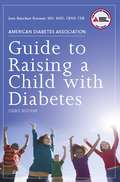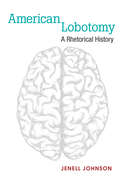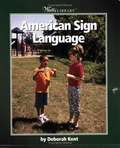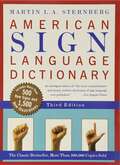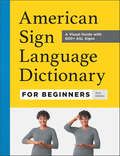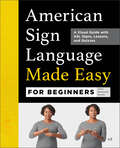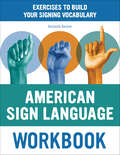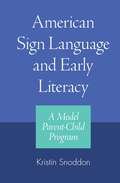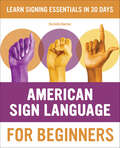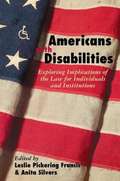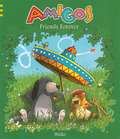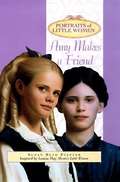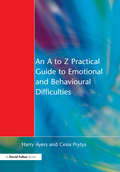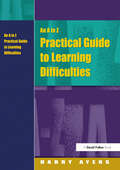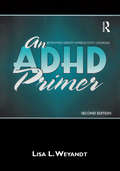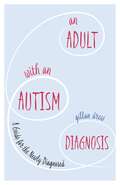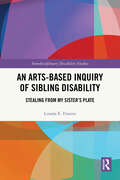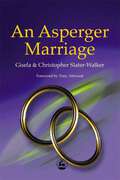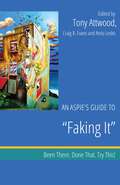- Table View
- List View
American Diabetes Association Guide to Raising a Child with Diabetes
by Jean Betschart RoemerThe American Diabetes Association Guide to Raising a Child with Diabetes, 3rd edition features the latest advances in diabetes care to help your child have a healthy active childhood. Full of problem-solving examples and easy-to-use tables, you will learn how:To adjust insulin to allow for the foods kids love to eatTo help the child with type 2 diabetesTo plan meals that are nutritious and balancedTo play sports and games safelyTo handle sick daysYour child can maintain a busy schedule and still feel healthy and strongTo negotiate the twists and turns of being "different"To accept the physical and emotional challenges that life has to offerAnd much more
American Lobotomy: A Rhetorical History
by Jenell JohnsonAmerican Lobotomy studies a wide variety of representations of lobotomy to offer a rhetorical history of one of the most infamous procedures in the history of medicine. The development of lobotomy in 1935 was heralded as a "miracle cure" that would empty the nation's perennially blighted asylums. However, only twenty years later, lobotomists initially praised for their "therapeutic courage" were condemned for their barbarity, an image that has only soured in subsequent decades. Johnson employs previously abandoned texts like science fiction, horror film, political polemics, and conspiracy theory to show how lobotomy's entanglement with social and political narratives contributed to a powerful image of the operation that persists to this day. The book provocatively challenges the history of medicine, arguing that rhetorical history is crucial to understanding medical history. It offers a case study of how medicine accumulates meaning as it circulates in public culture and argues for the need to understand biomedicine as a culturally situated practice.
American Sign Language
by Catherine NicholsIt's the third most used language in the United States-and yet it's "spoken" without even opening your mouth! It's estimated that as many as two million Americans speak American Sign Language, a method of communication that's both fun and useful, even if you or your friends and family are not hearing impaired.American Sign Language uses simple-to-follow photographs to teach you the alphabet, numbers, and simple words and phrases. Divided into categories such as Animals and People and Pronouns, the book and accompanying flashcards show you how to use your hands to communicate. Once you've learned the alphabet, you'll build on that knowledge to learn the words for "friend" and "family." And when you how the words for "chicken" and "cat" evoke a chicken opening and closing its beak and a cat stroking its whiskers, you'll truly understand how intuitive and enjoyable learning American Sign Language can be.Learning a new language is always a rewarding endeavor-and with American Sign Language, it's easier than ever!
American Sign Language
by Deborah KentThis book gives young readers a brief overview of American Sign Language (ASL). The book focuses on the history of ASL and the controversies which have surrounded it since its inception.
American Sign Language Dictionary
by Martin L. SternbergDeaf since the age of seven, Martin L. A. Sternberg, Ed.D., spent most of his career working with deaf people. Inspired by his sign language teacher at Gallaudet University in Washington, DC, he devised this vital reference to help anyone learn to speak with their hands. <p><p>A must for parents, instructors, and students, American Sign Language Dictionary includes everything you need to know to communicate clearly using ASL. This illustrated abridgment of the most authoritative reference book on sign language features more than 5,000 signs and 8,000 illustrations, as well as clear, detailed instructions to help you master each sign.
American Sign Language Dictionary for Beginners: A Visual Guide with 800+ ASL Signs
by Tara AdamsA user-friendly dictionary with 800+ ASL signs Whatever your reason for learning the richly expressive language of American Sign Language (ASL), this book will guide you through the initial stages of your signing journey. It's filled with everything you need to master more than 800 essential vocabulary words, including detailed directions that make it simple to develop your ASL skills.What sets this dictionary apart from other sign language books for beginners:No experience required—Find comprehensive, clearly written guidance that makes sense of American Sign Language for beginners, with helpful explanations of more difficult concepts, plus plenty of tips for success.Instructional photographs—See ASL in action with full-color photographs that illustrate how to sign each vocabulary word.Easy-to-find signs—Study each sign in alphabetical order or search by category with a handy index that organizes signs by activities, animals, emotions, places, events, and more.Build up your ASL vocabulary with the American Sign Language Dictionary for Beginners.
American Sign Language Made Easy for Beginners: A Visual Guide with ASL Signs, Lessons, and Quizzes
by Travis Belmontes-MerrellLearn American Sign Language the easy way! Become a lifelong learner of American Sign Language (ASL) with this guide for true beginners. It breaks down ASL fundamentals and gives you step-by-step instructions for signing more than 400 vocabulary words, organized by practical topics like greetings, hobbies, times, places, and more.The building blocks of ASL—Lay the foundation for ASL learning as you explore the five parameters of signing: handshape, location, movement, palm orientation, and non-manual markers.Clear guidance for novices—Learn how to sign each vocabulary word with the help of detailed written directions and large, full-color photos, so you know you're doing it right even if it's your first sign ever.Lessons and quizzes—Put your new skills to the test with themed lessons designed for real-world conversations, and brief quizzes at the end of each section.Make learning ASL fun and easy with this top choice in American Sign Language books for beginners.
American Sign Language Workbook: Exercises to Build Your Signing Vocabulary
by Rochelle BarlowThe simple way to start learning American Sign LanguageThis foundational workbook makes it easy to get started with American Sign Language. Focusing on practical vocabulary and basic grammar, this workbook is ideal for anyone trying to understand and speak ASL right away. Across 30+ lessons, you'll be introduced to the essentials, including everyday vocabulary, introductory phrases, and conversational basics.Everyday communication—Lessons are centered around real-world situations, including greetings, emotions, family, work, travel, and health.Easy-to-understand lessons—High-quality photos support the straightforward sign descriptions and ensure accurate instruction.Practice makes perfect—Test your knowledge with a variety of exercises, including matching, fill-in-the-blanks, and more.Lay the foundation for strong signing skills with the simple exercises in this sign language workbook.
American Sign Language and Early Literacy: A Model Parent-Child Program
by Kristin SnoddonThe usual definition of the term "literacy" generally corresponds with mastering the reading and writing of a spoken language. This narrow scope often engenders unsubstantiated claims that print literacy alone leads to, among other so-called higher-order thinking skills, logical and rational thinking and the abstract use of language. Thus, the importance of literacy for deaf children in American Sign Language (ASL) is marginalized, asserts author Kristin Snoddon in her new book American Sign Language and Early Literacy: A Model Parent-Child Program. As a contrast, Snoddon describes conducting an ethnographic, action study of the ASL Parent-Child Mother Goose program, provided by a Deaf service agency in Ontario, Canada to teach ASL literacy to deaf children. According to current scholarship, literacy is achieved through primary discourse shared with parents and other intimates, which establishes a child's initial sense of identity, culture, and vernacular language. Secondary discourse derives from outside agents and interaction, such as expanding an individual's literacy to other languages. Snoddon writes that the focus of the ASL Parent-Child Mother Goose program is on teaching ASL through rhymes and stories and some facets of the culture of Deaf ASL users. This focus enabled hearing parents to impart first-language acquisition and socialization to their deaf children in a more natural primary discourse as if the parents were Deaf themselves. At the same time, hearing parents experience secondary discourses through their exposure to ASL and Deaf culture. Snoddon also comments on current infant hearing screening and early intervention and the gaps in these services. She discusses gatekeeper individuals and institutions that restrict access to ASL for young Deaf children and their families. Finally, she reports on public resources for supporting ASL literacy and the implications of her findings regarding the benefits of early ASL literacy programming for Deaf children and their families.
American Sign Language for Beginners: Learn Signing Essentials in 30 Days
by Rochelle BarlowA 30-day beginner's guide for learning American Sign LanguageThere's an easy way to leap right in to learning American Sign Language (ASL). American Sign Language for Beginners delivers 30 days of lessons that will help you sign with those in your home, community, and classroom.From letters and numbers to essential vocabulary and grammar basics, this beginner's guide provides the essentials needed to develop a solid foundation for American Sign Language in the real world. Each daily lesson takes less than 30 minutes to complete and focuses on a single set of vocabulary or ASL grammar. Throughout the course, you'll find key phrases, helpful memory tips, signing practice activities, and insight into deaf culture. Start your ASL masterclass today.American Sign Language for Beginners includes:30 Days of easy ASL—Start off right with an accelerated plan designed to help you begin signing in just one month.Easy-to-understand instructions—Lessons concentrate on a single idea or subject and include photographs to demonstrate signs.Everyday phrases—Daily instruction highlights vocabulary you're most likely to need as you explore ASL in your daily life.Jump-start your learning experience with American Sign Language for Beginners!
American Sign Language for Kids: 101 Easy Signs for Nonverbal Communication
by Rochelle BarlowThe easy way for kids ages 3 to 6 (and parents) to learn American Sign LanguageThere has never been a better way to start learning American Sign Language. Ideal for parents of nonverbal children or children with communication impairments in the preschool or kindergarten age range, American Sign Language for Kids offers a simple way to introduce both of you to ASL.Build your vocabularies with 101 signs perfect for everyday use, all featuring detailed illustrations, memory tips, and hands-on activities. American Sign Language for Kids helps you focus on the types of words you need most with chapters conveniently divided by category. Get chatty with activities that guide you through conversations. You'll be signing together in no time!American Sign Language for Kids includes:101 Helpful signs—From family and feelings to meals and playtime, work with your child to master subjects that will help the two of you connect.Fun ways to practice—Discover enjoyable activities at the end of each section that make it exciting and engaging to learn signs and start conversing!Practical guides—Get useful advice for introducing signs to a child with autism, helpful primers on deaf culture, and more.Discover an effective and meaningful way to deepen communication with your child—American Sign Language for Kids shows you the way.
Americans with Disabilities: Exploring Implications of the Law for Individuals and Institutions
by Anita Silvers Leslie Pickering FrancisFew laws have sparked as much debate as the Americans with Disabilities Act (ADA), passed by Congress in 1990. With thought-provoking analysis by noted experts in a variety of fields, this book provides a keen understanding of the consequences of the law--for both those who oppose burdensome costs of the law and those who feel it must do more to protect citizens with disabilities from intolerance and social limitation.
Amigos: Friends Forever
by WalkoThe world can present many obstacles-for people with a handicap, simply getting from place to place can be a major challenge. A dog named Pedro wants to explore the world but his lack of sight makes it too dangerous for him to dodge the whizzing cars on a busy street. He meets Rosalie the cat, who is also on a journey but her damaged leg prevents her from crossing the street quickly and unharmed. The pair realizes that they can use each other's strengths to work together and accomplish the task.A charming story about friendship and special needs, incorporating Spanish words with humor and wit, Amigos shows that anything is possible with a caring friend by your side. Even with handicaps, Pedro and Rosalie are able to overcome the hardest challenges by sticking together. This book will teach children the value of friendship, acceptance, and perseverance.
Amy Makes a Friend (Portraits of Little Women)
by Susan Beth PfefferAmy March wants to be a great artist. She's got the talent; now all she needs is a way to afford art lessons. Her solution: befriend her rich and snobby classmate, Jenny Snow, who'll then invite Amy to sit in on her private art instructions. But Jenny can't be bothered with Amy's friendly overtures -- until Diana Hughes, a new and extremely wealthy girl, chooses Amy as her friend. Now, Amy thinks Jenny will like her too. But the price of art lessons may be higher than Amy ever imagined....
Amy Signs: A Mother, Her Deaf Daughter, and Their Stories
by Amy Willman Rebecca Willman Gernon“Thirty-seven years ago, I vowed to write a truthful book about raising a deaf child.” Rebecca Willman Gernon followed through on her promise with her deaf daughter Amy Willman in this extraordinary new narrative. Many stories have been told about a parent’s struggle to help her deaf child succeed in a mostly hearing world. Amy Signs marks a signature departure in that both Rebecca and Amy relate their perspectives on their journey together. When she learns of 11-month-old Amy’s deafness in 1969, Rebecca fully expresses her anguish, and traces all of the difficulties she endured in trying to find the right educational environment for Amy. The sacrifices of the rest of her family weighed heavily on her, also. Though she resolved to place four-year-old Amy in Nebraska’s residential school for deaf students, the emotional toll seemed too much to bear. Amy’s view acts as the perfect counterpoint. Interwoven with her mother’s story, Amy’s account confirms that signing served her best. She summarizes life in boarding school as “laughter and homesickness.” She laughed with all of her deaf friends, though felt homesick at times. Amy thanks her mother for the gift of sign, asserting that a mainstream education would never have led her to earn a master’s degree and later teach American Sign Language at the University of Nebraska. Amy Signs is a positive albeit cautionary tale for parents of deaf children today whose only choice is a mainstreamed education.
An A to Z Practical Guide to Emotional and Behavioural Difficulties
by Harry Ayers Cesia PrytysThe aim of this practical and user-friendly A to Z handbook is to enable the interested reader to gain quick and easy access to entries relating to or associated with emotional and behavioral difficulties. It focuses on adult problems as well as those of children and adolescents. The entries clearly and succinctly define and explain emotional behavioral terms and some of the different ways in which emotional and behavioral problems can be approached or treated. Where appropriate, entries are accompanied by a brief bibliography. Useful addresses and contact phone numbers are also provided where appropriate. This guide is useful for all teachers, mentors, social workers, educational social workers, educational psychologists, counselors, care workers, students and other professionals and voluntary workers in allied fields. It will also be of interest to parents and carers.
An A to Z Practical Guide to Learning Difficulties
by Harry Ayers Francesca GrayAccessing up-to-date information about general and specific learning difficulties is made easy, with this indispensable reference book. Covering difficulties that relate to children, adolescents and adults, it includes: crucial legislation to keep practitioners 'in the know' useful addresses, telephone numbers and websites It also includes explanations of leaning difficulties including those less than well-known syndromes such as semantic pragmatic difficulties.
An ADHD Primer
by Lisa L. WeyandtFilled with current, practical, and useful information for professionals and individuals, this second edition of An ADHD Primer summarizes the literature concerning ADHD across the lifespan. It offers a better understanding of the disorder by addressing the potential causes of ADHD, the developmental course, and numerous treatment approaches. Author Lisa L. Weyandt delivers research-based, cutting-edge knowledge in a concise and user-friendly fashion. The book skillfully explains the scientific literature, often complex, concerning this disorder. Commonly asked questions are addressed, including: What causes ADHD? What does ADHD look like, and how can it be accurately assessed? How can ADHD be treated with and without medication? Weyandt thoroughly tackles these question and more. The text contains helpful tables and appendices, as well as numerous up-to-date resources for readers who desire additional information about the disorder. An ADHD Primer is intended for students enrolled in teacher-certification programs, graduate students enrolled in research and applied training programs, educators, counselors, nurses, psychologists, parents, and individuals with ADHD.
An Adult with an Autism Diagnosis: A Guide for the Newly Diagnosed
by Gillan DrewBeing diagnosed with autism as an adult can be disorienting and isolating; however, if you can understand the condition and how it affects perceptions, relationships, and your relationship with the world in general, a happy and successful life is attainable. Through an introduction to the autism spectrum, and how the Level 1 diagnosis is characterised, the author draws on personal experiences to provide positive advice on dealing with life, health, and relationships following an adult diagnosis. The effect of autism on social skills is described with tips for dealing with family and personal relationships, parenting, living arrangements, and employment. Important topics include disclosure, available resources, and options for different therapeutic routes. On reading this book, you will learn a lot more about the autism spectrum at Level 1, be able to separate the facts from the myths, and gain an appreciation of the strengths of autism, and how autism can affect many aspects of everyday life. Drawing from the author's lived experience, this book is an essential guide for all newly diagnosed adults on the autism spectrum, their families and friends, and all professionals new to working with adults with ASDs.
An Adult with an Autism Diagnosis: A Guide for the Newly Diagnosed
by Gillan DrewBeing diagnosed with autism as an adult can be disorienting and isolating; however, if you can understand the condition and how it affects perceptions, relationships, and your relationship with the world in general, a happy and successful life is attainable. Through an introduction to the autism spectrum, and how the Level 1 diagnosis is characterised, the author draws on personal experiences to provide positive advice on dealing with life, health, and relationships following an adult diagnosis. The effect of autism on social skills is described with tips for dealing with family and personal relationships, parenting, living arrangements, and employment. Important topics include disclosure, available resources, and options for different therapeutic routes. On reading this book, you will learn a lot more about the autism spectrum at Level 1, be able to separate the facts from the myths, and gain an appreciation of the strengths of autism, and how autism can affect many aspects of everyday life. Drawing from the author's lived experience, this book is an essential guide for all newly diagnosed adults on the autism spectrum, their families and friends, and all professionals new to working with adults with ASDs.
An Archaeology of Yearning
by Bruce MillsDigging into vivid moments within the metaphor of archaeology, Bruce Mill's remarkable memoir maps the artifacts of life as a father of a boy with autism, and as a boy himself growing up in rural Iowa. An Archaeology of Yearning is not ultimately about autism; instead it reaches into the world of human connection and illuminates how storytelling and an understanding of language keep that connection alive.On some nights, I awake as if in a cave and think of the future. Mary and I will exist as memories: a quick glimpse of arms reaching toward another's shoulders or face, an image of a hand upon a book, the scent of our bodies after the sweat of sleep, the tone of our young and old voices calling our daughter or son from distant rooms or down a stair.Eventually I arrive on the image of my son, in some new home. No matter how much I have written or catalogued or kept in images, I know that the site of his life and mine will inevitably remain fragments and that only a visitor can bring us to life.Bruce Mills has published scholarly books and articles on nineteenth-century American writings and co-edited a collection of essays by siblings of those on the autism spectrum. His creative nonfiction has appeared in The Georgia Review and New England Review. He teaches in the English Department at Kalamazoo College.
An Arts-Based Inquiry of Sibling Disability: Stealing from My Sister’s Plate (Interdisciplinary Disability Studies)
by Linnéa E. FranitsThis book examines texts and other artistic products rendered by siblings of individuals with disabilities in order to interrogate the impact of disability on the identity of non-disabled siblings. This includes an arts-based analysis of the author’s own experiences as the sister of a woman with disabilities as depicted in photo essays and autoethnographic texts. By providing an alternate presentation of the topics surrounding sibling disability it gives readers a deeper and broader perspective of the lived experience of sibling disability by introducing them to some of the knowledge that is specifically, and perhaps singularly available to siblings of people with disabilities. Presenting findings from narrative analysis, visual analysis, autoethnographic and arts-based research related to sibling disability, it challenges the grand narratives that persist in many cultural products and medical discourses around sibling disability.It will be of interest to all scholars and students of disability studies, sociology, childhood studies, family studies and the arts more broadly.
An Asperger Marriage
by Tony Attwood Gisela Slater-Walker Christopher Slater-WalkerChris and Gisela have been partners for twelve years. Four years ago Chris was diagnosed with Asperger syndrome. For Chris, this was an explanation of why he had always regarded himself as 'socially handicapped'. For Gisela, it meant coming to terms with a marriage in which there would never be an intuitive understanding despite Chris's good intentions. For the couple it was the beginning of a long and still unfinished process of learning to live with a disability regarded by some as incompatible with marriage.
An Aspie’s Guide to "Faking It": Been There. Done That. Try This!
by Tony Attwood Anita Lesko Craig EvansIn order to survive in a Neurotypical world many Aspies feel that they need "fake it" and intentionally wear a mask and play a role so that people will not see who they really are. This can be exhausting and "faking it" is a key daily stressor for people with Asperger's Syndrome. This ebook is packed with advice from Aspie mentors who have all been there, done that, and offer suggestions for coping strategies that really work. Liane Holliday Willey, Jennifer Cook O'Toole, Karen Krejcha and more offer guidance based on their personal experiences of "faking it" and the ebook ends with professional analysis and recommendations from world expert Dr. Tony Attwood. This inspirational advice comes from the bestselling book Been There. Done That. Try This!, written by Aspies for Aspies, now available in short Aspie Mentor Guides!
An Aspie’s Guide to Accepting and Working with Change: Been There. Done That. Try This!
by Tony Attwood Anita Lesko Craig EvansChange is a key daily stressor for people with Asperger's Syndrome and this ebook is packed with advice from Aspie mentors who have all been there, done that, and offer suggestions for coping strategies that really work. Temple Grandin, Lars Perner, Liane Holliday Willey, and more offer guidance based on their personal experiences of accepting and working with change and the ebook ends with professional analysis and recommendations from world expert Dr. Tony Attwood. This inspirational advice comes from the bestselling book Been There. Done That. Try This!, written by Aspies for Aspies, now available in short Aspie Mentor Guides!
